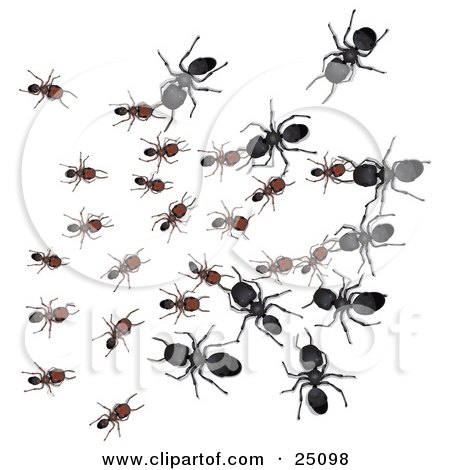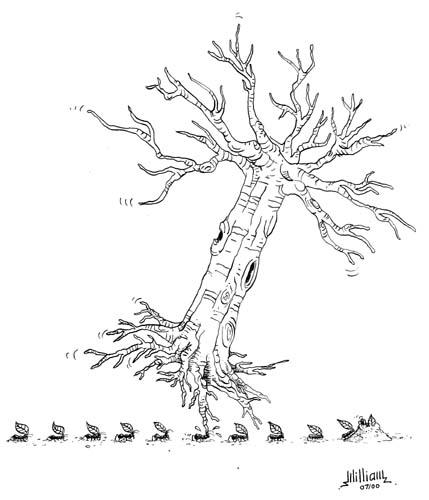 I'd like to introduce a fresh new approach to computer security modeling nature; from the Wake Forest University! Two keywords scent and ants! Yes, as you may guess, security experts are deploying a new defense modeled after one of nature's hardiest creatures — the ant as reported in this article titled "Ants vs. worms Computer security mimics nature"!
I'd like to introduce a fresh new approach to computer security modeling nature; from the Wake Forest University! Two keywords scent and ants! Yes, as you may guess, security experts are deploying a new defense modeled after one of nature's hardiest creatures — the ant as reported in this article titled "Ants vs. worms Computer security mimics nature"!This study report highlights that unlike traditional security devices, which are static, these "digital ants" wander through computer networks looking for threats, such as "computer worms" — self-replicating programs designed to steal information or facilitate unauthorized use of machines. When a digital ant detects a threat, it doesn't take long for an army of ants to converge at that location, drawing the attention of human operators who step in to investigate.
 The concept, called "swarm intelligence," promises to transform cyber security because it adapts readily to changing threats. Professor of Computer Science Errin Fulp says "In nature, we know that ants defend against threats very successfully. They can ramp up their defense rapidly, and then resume routine behavior quickly after an intruder has been stopped. We were trying to achieve that same framework in a computer system. Our idea is to deploy 3,000 different types of digital ants, each looking for evidence of a threat. As they move about the network, they leave digital trails modeled after the scent trails ants in nature use to guide other ants. Each time a digital ant identifies some evidence, it is programmed to leave behind a stronger scent. Stronger scent trails attract more ants, producing the swarm that marks a potential computer infection."
The concept, called "swarm intelligence," promises to transform cyber security because it adapts readily to changing threats. Professor of Computer Science Errin Fulp says "In nature, we know that ants defend against threats very successfully. They can ramp up their defense rapidly, and then resume routine behavior quickly after an intruder has been stopped. We were trying to achieve that same framework in a computer system. Our idea is to deploy 3,000 different types of digital ants, each looking for evidence of a threat. As they move about the network, they leave digital trails modeled after the scent trails ants in nature use to guide other ants. Each time a digital ant identifies some evidence, it is programmed to leave behind a stronger scent. Stronger scent trails attract more ants, producing the swarm that marks a potential computer infection." I know we mimicked a number of animals for computer security in the past. Even some mythological characters such as three headed Cerberus watching Hades! What other animals or even plants could we model for computer security? Please illustrate your thoughts with your real and/or imaginative animals and their cognitive expertise such as smell, taste, touch, bite are a few for the consideration of your imagination!
I know we mimicked a number of animals for computer security in the past. Even some mythological characters such as three headed Cerberus watching Hades! What other animals or even plants could we model for computer security? Please illustrate your thoughts with your real and/or imaginative animals and their cognitive expertise such as smell, taste, touch, bite are a few for the consideration of your imagination!Regards,
Mehmet
Dr. Mehmet YILDIZ || IBM || IT Philosophy || Future|| Leadership || My blog || Twitter || Linkedin || Yasni ||Google || Naymz|| Superfan
 We all of course have different views and experience on dealing with bad news. This is also very contextual and may vary according to the situation. Maybe we can learn from each other by identifying some practical patterns and handy hints. How do you usually deliver bad news to the related parties who are expected to suffer from or be disadvantaged by the intended severe bad news?
We all of course have different views and experience on dealing with bad news. This is also very contextual and may vary according to the situation. Maybe we can learn from each other by identifying some practical patterns and handy hints. How do you usually deliver bad news to the related parties who are expected to suffer from or be disadvantaged by the intended severe bad news? I didn't fully make up the title of this post, it came from Northwestern University, a research report for media. Their title is "
I didn't fully make up the title of this post, it came from Northwestern University, a research report for media. Their title is " I found their method very interesting and unusual because they examined extensive letter correspondence records of 16 famous writers, performers, politicians and scientists, including Einstein, Darwin, Sigmund Freud, Karl Marx, and Ernest Hemingway, and found that the 16 individuals sent letters randomly but in cycles. They said "No matter what their profession, all the letter writers behaved the same way. They adhered to a circadian cycle; they tended to write a number of letters at one sitting, which is more efficient; and when they wrote had more to do with chance and circumstances than a rational approach of writing the most important letter first."
I found their method very interesting and unusual because they examined extensive letter correspondence records of 16 famous writers, performers, politicians and scientists, including Einstein, Darwin, Sigmund Freud, Karl Marx, and Ernest Hemingway, and found that the 16 individuals sent letters randomly but in cycles. They said "No matter what their profession, all the letter writers behaved the same way. They adhered to a circadian cycle; they tended to write a number of letters at one sitting, which is more efficient; and when they wrote had more to do with chance and circumstances than a rational approach of writing the most important letter first." I am unable to find more on this behavioural study however added this paper to my to read list as soon as it becomes available. Related to this topic, I noticed Mark Rhodes posted an interesting blog on Friday titled "
I am unable to find more on this behavioural study however added this paper to my to read list as soon as it becomes available. Related to this topic, I noticed Mark Rhodes posted an interesting blog on Friday titled " Yes, we will shake it like
Yes, we will shake it like  1. How likely to use digital tongues to speak, to taste the quality of communication!
1. How likely to use digital tongues to speak, to taste the quality of communication! What other digital occurrences and things we can introduce to our end to end communication process and tools? You are free to stretch your prediction up to 2050 safely and for the remaining years and centuries, I will facilitate another blog soon.
What other digital occurrences and things we can introduce to our end to end communication process and tools? You are free to stretch your prediction up to 2050 safely and for the remaining years and centuries, I will facilitate another blog soon.


















